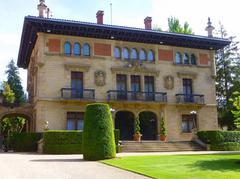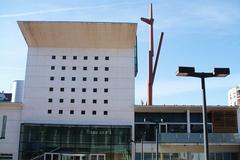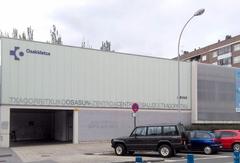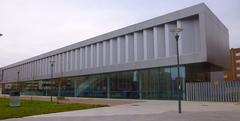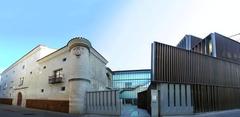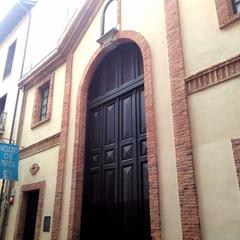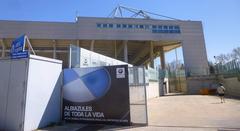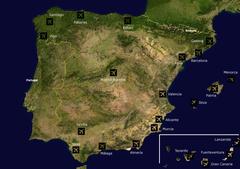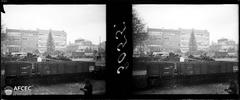
Tower of Mendoza: Visiting Hours, Tickets, and Historical Sites in Vitoria-Gasteiz
Date: 04/07/2025
Introduction
Nestled just outside Vitoria-Gasteiz in Spain’s Basque Country, the Tower of Mendoza (Torre de Mendoza) is a striking example of medieval architecture and noble heritage. Built in the late 13th or early 14th century by the influential Mendoza family, this fortress-tower played a dual role as a defensive stronghold and aristocratic residence, embodying the complex feudal landscape of Álava and the broader Basque region (Basque Country Guide; Castlepedia). Today, the tower stands as a well-preserved monument, offering visitors insights into medieval Basque society, architecture, and heraldry, alongside practical information for planning a visit.
Historical Overview
Origins and Construction
The Tower of Mendoza was commissioned by the Mendoza family during a time of frequent territorial disputes in medieval Álava. Its robust, rectangular structure—built with locally quarried stone—features thick walls, crenellations, arrow slits, and fortified entrances, all characteristic of Gothic military architecture adapted to local needs (Castlepedia). The tower was strategically positioned to oversee vital routes, reinforcing the Mendoza family’s control and regional influence.
The Mendoza Family and Their Legacy
The Mendoza family rose to prominence through military service, strategic marriages, and alliances with the Castilian crown. Iñigo López de Mendoza, a key figure, distinguished himself at the 1212 Battle of Las Navas de Tolosa, earning the right to add chains to the family coat of arms—a symbol still visible at the tower (Kids Kiddle; Spotting History). Over time, the family’s power extended through Álava and Castile, leaving an enduring mark on the region’s history (Wikipedia).
Architectural Features
Defensive Elements
The Tower of Mendoza’s formidable design reflects its primary defensive function. Its exterior boasts battlements, arrow slits for archers, and a fortified gatehouse protected by a portcullis. Machicolations at the parapet allowed defenders to repel attackers, while a surrounding stone wall reinforced security (architecturelab.net; spanish-architecture.info).
Residential and Symbolic Aspects
Beyond military features, the tower’s upper levels contain more comfortable living quarters, fireplaces, and large windows, signaling the Mendoza family’s noble status. Heraldic shields and emblems are prominently displayed, asserting lineage and legitimacy (Euskadi Tourism).
Adaptation Over Time
Through the centuries, the tower was periodically updated for changing needs—serving as a residence, administrative center, and even a prison after the Mendoza family relocated. In the 20th century, it housed the Museum of Heraldry of Álava, exhibiting family crests and medieval artifacts (Spotting History). Today, the tower is a protected cultural landmark, with ongoing preservation efforts ensuring its survival (Wikipedia).
Visiting the Tower of Mendoza
Opening Hours
The Tower of Mendoza generally welcomes visitors from Tuesday to Sunday, with standard visiting hours between 10:00 AM and 6:00 PM. Hours can vary seasonally or during special events, so it is advisable to consult the official tourism website or contact the local tourist office before your visit.
Tickets and Admission
Tickets are affordably priced, typically around €5 for adults, with discounts for children, seniors, and groups. Tickets can be purchased onsite or online; advance purchase is recommended during peak seasons. Guided tours, often included in the ticket price, offer deeper historical context and access to otherwise restricted areas (Euskadi Tourism).
Accessibility
Due to the tower’s medieval layout—narrow staircases and uneven stone floors—accessibility is limited, especially for visitors with mobility impairments. The exterior grounds are accessible, and those needing assistance should contact the site in advance.
Guided Tours and Special Events
Guided tours are highly recommended to appreciate the tower’s rich history and architectural details. The site occasionally hosts medieval-themed events and workshops, especially during festivals. Check the event calendar for unique experiences (touristear.com).
Exploring Nearby Vitoria-Gasteiz Historical Sites
Vitoria-Gasteiz is renowned for its well-preserved medieval quarter, known as the “Medieval Almond,” home to:
- Cathedral of Santa María: A UNESCO World Heritage site offering guided tours.
- Fournier Playing Card Museum: Located in Bendaña Palace, featuring a world-class card collection.
- Medieval Walls and Watchtowers: Remnants of the city’s original fortifications.
Combine your visit to the Tower of Mendoza with these attractions for a comprehensive journey through Álava’s history (unstoppablestaceytravel.com).
Visitor Tips
- Check for Special Events: Look for medieval reenactments and educational workshops.
- Dress Appropriately: Wear comfortable shoes and layered clothing.
- Photography: Allowed throughout the site; flash and tripods may be restricted.
- Language: Tours are primarily in Spanish and Basque, with occasional English options.
- Sustainability: Use public transport and respect local customs to support Vitoria-Gasteiz’s green initiatives.
Frequently Asked Questions (FAQ)
Q: What are the Tower of Mendoza’s visiting hours?
A: Typically Tuesday to Sunday, 10:00 AM to 6:00 PM. Check the official site for seasonal updates.
Q: How can I buy tickets?
A: Tickets are available onsite and online; advance purchase is advisable during busy periods.
Q: Is the site wheelchair accessible?
A: Due to historic architecture, upper floors are not accessible, but ground areas can be visited.
Q: Are guided tours available?
A: Yes, both scheduled and by request, often included in the ticket price.
Q: Can I take photos inside the tower?
A: Photography is permitted, but restrictions may apply to flash and tripods.
Conclusion
The Tower of Mendoza is a remarkable testament to Álava’s medieval heritage and the enduring legacy of the Mendoza family. Its blend of defensive features, noble symbolism, and evolving functions throughout history makes it a must-see for anyone interested in the Basque Country’s past. By planning ahead—checking visiting hours, booking tickets, and considering accessibility—you can ensure a memorable and enriching experience.
For more information, interactive maps, and guided tour options, download the Audiala app, follow us on social media, and consult official tourism platforms. Make the most of your journey by exploring the wider historical and cultural offerings of Vitoria-Gasteiz and the Basque Country.
























